| |||
| Heiligkreuz (Voivodeship) | |||
| Capital | Kielce | ||
|---|---|---|---|
| Residents | 1.241.546 (2018) | ||
| surface | 110.6 km² | ||
| no tourist info on Wikidata: | |||
| location | |||
 | |||
&groups=Maske,Track,Aktivitaet,Anderes,Anreise,Ausgehen,Aussicht,Besiedelt,Fehler,Gebiet,Kaufen,Kueche,Sehenswert,Unterkunft,aquamarinblau,cosmos,gold,hellgruen,orange,pflaumenblau,rot,silber,violett)
The Świętokrzyskie Voivodeship(Polish: Województwo świętokrzyskie) is in the southern Poland with the capital Kielce. It borders on the south Lesser Poland Voivodeship, in the west to the voivodeships Łódź and Silesia, in the east to the voivodships Lublin and Subcarpathian and in the north to the Masovian Voivodeship. The central part of the second smallest Polish voivodeship in terms of area is formed by the Heiligkreuzgebirge embossed. The north of the voivodeship is through the valley of the Kamienna embossed while the Vistula represents the southern and eastern border. Your tributary that Nida pervades that Nida Basin in the south. In the west the area extends almost to the Pilitza in the Krakow-Czestochowa Jura and to the Mechauer Plateau in the southwest.
In the region you can find traces of the dinosaurs, beautiful stalactite caves, evidence of human settlement in the Stone and Early Iron Ages, early medieval pagan places of worship, Romanesque-Gothic monasteries, Florentine Renaissance architecture, traces of the Polish Reformation, especially the Polish brothers, Evidence of Jewish life as well as an early industrial culture and interesting mountain ranges. There are good opportunities for water sports at the numerous reservoirs and rivers. The kayak route along the Kamienna is particularly recommended. A third of the area is made up of partly untouched wild forests. The Heiligkreuzgebirge has its own charm. The provincial capital and university city of Kielce in particular offers an interesting cultural program.
Regions

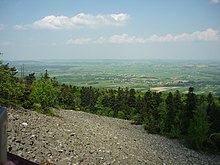
The name Holy Cross derives from that Heiligkreuzgebirge which occupies the central part of the voivodeship. The name of the mountain goes back to the Benedictine monastery Heiligkreuz Nowa Słupia which in turn goes back to the mountain summit of the same name on which it is located. The Gergpfel was pagan Wislanen holy and they operated a place of worship there in the early Middle Ages, which was established in the 9th century as part of the vom Great Moravian Empire outgoing forced Christianization was destroyed. Instead of the place of worship, the Christian missionaries are said to have erected a summit cross, from which first the mountain and then the monastery on the Holy Cross, built around the year 1000, got its name. Finally, relics of the Holy Cross were also brought into the monastery to emphasize the naming.
The Heiligkreuz area belonged politically since the early Middle Ages Lesser Poland. Next to the Heiligkreuzgebirge, which is partly in Heiligkreuz National Park is protected, it also has a share in the south Nida-Pool and the Mechauer Highlands as well as in the east on that Lesser Poland Vistula breakthrough by the Polish highlands. That forms the north Valley of Kamienna and the Kielcer Highlands.
- In the north of the Valley of Kamienna to Vistula. In the ancient rock layers of the valley there are numerous fossils, which the Dinasaurierpark in Bałtów Pays tribute. In the Stone Age, Europe's largest quarrying area for flint, which is part of the UNESCO World Heritage Site, was located here Krzemionki can visit. Remains of furnaces come from the Bronze and Iron Ages, where the ore, which is abundant here, was melted down. From the Middle Ages to industrialization, the valley was also called Old Polish industrial area is designated the main center of mines, furnaces and forges in Poland-Lithuania. Only with the actual industrialization did the companies relocate to Lesser Poland and Silesian brazier and the Heiligkreuz-Heath took back the area. Numerous reservoirs were created here from the beginning of the 20th century.
- This is located south of the Kamienna Valley Heiligkreuzgebirge, which for the most part as Heiligkreuz National Park is protected. The picturesque and easily accessible one Heiligkreuz main hiking trail leads through its central part. On the highest mountain, the Holy Cross, stands the thousand year old Benedictine monastery of the same name. The mountains are among the oldest in the world and are already largely eroded. Nonetheless, the ancient rocks and scree fields create a fairytale landscape that has given rise to numerous legends about witches, giants and wizards.
- To the south of the Świętokrzyskie Mountains are the fertile plains that extend as far as the Vistula: Mechau plateau, Nida basin, Sandomir plateau as well as in the very east of the Lesser Poland Vistula Gorge. This is where I found the most important forts of the Wislanes in the early Middle Ages, among others Wiślicawhich later made important trading cities like Opatów or Sandomierz were. After the Christianization of Poland, numerous monasteries were built here along the Vistula, which the lands with the Cracow Bishops and the crown estates shared. During the Renaissance, the local nobility brought Florentine artists from Krakow, who rebuilt the local castles and churches in the Florentine style based on the model of the Krakow Wawel. During the Reformation this was the center of Polish Protestantism. Around the middle of the 16th century, universities and printing houses of the Calvinists and Polish brothers were established here. It was here that the first complete translation of the Bible into Polish was organized and printed.
- In the northeast, the voivodeship has a stake in the Malopolska Plateau with the Kielcer Highlands between the Krakow-Czestochowa Jura and the Heiligkreuzgebirge and from the Pilitza is traversed.
places
Kamienna valley
- 1 Suchedniów

- 2 Skarżysko-Kamienna

- 3 Wąchock

- 4 Starachowice

- 5 Kunów

- 6 Ostrowiec Świętokrzyski

- 7 Ćmielów

- 8 Krzemionki
- 9 Bałtów
- 10 Ożarów

Heiligkreuzgebirge
- 11 Małogoszcz

- 12 Chęciny

- 13 Morawica

- 14 Pierzchnica
- 15 Kielce

- 16 Daleszyce

- 17 Nowa Słupia

- 18 Łagów

- 19 Święta Katarzyna
- 20 Szydłów

- 21 Raków

- 22 Ujazd
- Opatów

Sandomir plateau
- 23 Zavichost

- 24 Sandomierz

- 25 Klimontów

- 26 Koprzywnica

- 27 Osiek

Nida basin
- 28 Staszów

- 29 Połaniec

- 30 Oleśnica

- 31 Pacanów

- 32 Chmielnik

- 33 Stopnica
- 34 Busko-Zdrój

- 35 Solec-Zdrój
- 36 Nowy Korczyn
- 37 Wiślica

- 38 Bejsce
- 39 Opatowiec

- 40 Pińczów

- 41 Jędrzejów

Mechau plateau
- 42 Sędziszów

- 43 Działoszyce

- 44 Skalbmierz

- 45 Kazimierza Wielka

Lesser Poland plateau
- 46 Włoszczowa

- 47 Radoszyce

- 48 Końskie

- 49 Stąporków

Other goals

Kayak and houseboat trails

- Czarna Konecka
- Czarna Staszowska
- Iłżanka
- Kamienna
- Koprzywianka
- Mierzawa
- Nida
- Nidzica
- Pilitza
- Vistula
- Wschodnia
Lakes
- 1 Brody Reservoir
- 2 Chańcza Reservoir
- 3 Lubianka reservoir
- 4 Piachy reservoir
- 5 Rejów Reservoir
- 6 Starachowice reservoir
- 7 Wióry reservoir
- 8 Wąchock reservoir
- 9 Zgórsko reservoir
background
The Heiligkreuzgebirge has always been considered the Mecca of witches and wizards and the Heiligkreuzberg, also known as the Kahler Berg, as the place of Walpurgis Night, where the dark forces come together. This goes back to the fact that a pagan place of worship was located here before Lesser Poland was part of the Great Moravian Empire in the 8th / 9th centuries. Christianized in the 19th century. In order to drive out the pagan gods, a cross was first erected and later a monastery was erected on the mountain top.
The mountains themselves are ancient. Its rocks, which date back to the Precambrian, contain numerous fossils from several geological ages. The mountains were folded half a billion years ago and are already largely eroded. What remains are gentle mountain ridges with bizarre rock formations and scree meadows. It is backed by a dense jungle that Heiligkreuz-Heath, overgrown.
There are numerous natural resources in the mountains and their valleys. These have been mined since the Stone Age, for example in the flint mine Krzemionki. Ores were processed in numerous furnaces during the Bronze and Iron Ages. From the Middle Ages, the region was the most important industrial area in Poland and later Poland-Lithuania. It is still referred to as the Old Polish Industrial Area to this day, even though industry migrated to the nearby Lesser Poland and Upper Silesian coal basins in the 19th century.
Today's Świętokrzyskie Voivodeship was part Lesser Poland, from the time of Polish particularism from the 12th century part of the Principality of Sandomir. Numerous monasteries were founded from the turn of the millennium before last, which also owned a large part of the lands. Other important landlords were the Kraków bishops. Many Italian artists and scholars at the Kraków royal court settled here. For example, the Renaissance sculptor and architect Santi Gucci set up his workshop in Pińczówbecause there was marble deposits here. The region was also the center of the Calvinist Reformation in Poland-Lithuania and the Polish Brothers in the 16th century. Two short-lived Protestant universities emerged here, which among other things produced the first complete translation of the Bible from the original languages into Polish.
language
Polish is the official and colloquial language. Polish is spoken with the Lesser Poland dialect. In Heiligkreuz, the foreign language skills of the population are good. Almost all of the younger residents speak very good or good English. Many also have a second foreign language such as German, French, Spanish, Italian or Russian. And finally, Polish is not as difficult to learn as you might think at first.
getting there
We recommend arriving by car, bus or train. The journey is recommended from Wroclaw and Krakow about the Autostrada A4. The airport in Germany, Austria and Switzerland can be reached by plane Katowice, Krakow or Warsaw approach.
By plane
In the Heilikreuz Voivodeship, there is no international airport in contrast to all neighboring voivodeships. You can travel by plane from Germany, Austria and Switzerland 1 Lublinek Airport![]() (IATA: LCJ) at Łódź, 2 Pyrzowice Airport
(IATA: LCJ) at Łódź, 2 Pyrzowice Airport![]() (IATA: KTW) at Katowice, the 3 Balice airport
(IATA: KTW) at Katowice, the 3 Balice airport![]() (IATA: CRC) at Krakow, 4 Jasionka Airport
(IATA: CRC) at Krakow, 4 Jasionka Airport![]() (IATA: RZE) at Rzeszów, 5 Lublin Airport
(IATA: RZE) at Rzeszów, 5 Lublin Airport![]() (IATA: LUZ) at Lublin or the 6 Okęcie Airport
(IATA: LUZ) at Lublin or the 6 Okęcie Airport![]() (IATA: WAW) at Warsaw approach.
(IATA: WAW) at Warsaw approach.
road
The road conditions and the rail network are mediocre. The journey is recommended from Krakow via the well-developed expressway S7 or on the country road along the Vistula.
By train
The rail network is also mediocre. The journey is recommended from Krakow to Kielce. There are some historic narrow-gauge railways that take tourists through the mountainous landscape.
By boat
With the excursion boat you can go over the Vistula Arriving from the north and south. Numerous Vistula ferries operate in Subcarpathian, to Lublin and after Lesser Poland.
mobility
The point of transport is the capital Kielce. The road network is mediocre. This also applies to bus and train connections. The best way to get from A to B is with your own car or motorcycle.
From north to south the voivodeship is crossed by the S7 expressway from Danzig above Warsaw to Krakow cut through.
Tourist Attractions


1.jpg/220px-Szydlow(js)1.jpg)
Especially worth seeing:
- the Heiligkreuzgebirge with the millennial Heiligkreuz Monastery
- Kielce has a beautiful baroque bishop's palace and many baroque churches.
- Sandomierz is a beautiful medieval trading town on the Vistula.
- Jędrzejów is has a Cistercian abbey with wonderful baroque organs.
- Busko-Zdrój is a popular climatic health resort.
- Solec-Zdrój is right next to Busko and is also a popular climatic health resort, albeit less known.
- Wiślica was one of the first cultural centers in Lesser Poland, already at the time of the Great Moravian Empire.
- the Krzyżtopór Palace in Ujazd is the ruin of the early baroque palace, which was considered the largest palace in Europe before Versailles was built.
- in Chęciny there is a picturesque medieval castle ruin on the edge of the Świętokrzyskie Mountains
- in Chęciny there is also the stalactite cave Raj, which is considered to be the most beautiful show cave in Poland.
- Wąchock has a well-known Romanesque monastery.
- in Krzemionki is the UNESCO World Heritage Site of Europe's largest Stone Age flint mine.
- in Bałtów there is a dinosaur park that ties in with the fossils found here.
- Szydłów has one of the best preserved Gothic city walls in Central Europe.
- Raków was the center of the Polish Brethren, their university and printing house during the Reformation.
- Opatów has a beautiful medieval old town.
- Klimontów is known for its beautiful Renaissance architecture.
- Koprzywnica has a Romanesque-Gothic Cistercian monastery.
- Jędrzejów has the oldest Romanesque-Gothic Cistercian monastery in Poland.
- Skalbmierz has a beautiful Gothic basilica.
- Bejsce has a renaissance chapel by Santi Gucci, which mimics the Sigismund chapel on the Kraków Wawel.
- Staszów has a renaissance chapel by Santi Gucci, which mimics the Sigismund chapel on the Kraków Wawel.
- Pińczów also has a renaissance chapel by Santi Gucci, which imitates the Sigismund chapel on the Kraków Wawel. The city was the center of the Polish Calvinists.
- Stopnica has a very beautiful Gothic church with a Renaissance chapel.
- Nowy Korczyn was an important trading town on the Vistula.
- Końskie owns a rococo palace complex
activities
Hiking, cycling, horse riding and water sports are all on offer. In winter, winter sports can be practiced in the mountains.
kitchen
The south of the region in the Vistula Valley is known in Poland as a fruit and vegetable chamber. Fresh apples, pears, peaches, cherries, tomatoes, cucumbers, honey etc. are in abundance. The mountains, rich in forests and water, provide fresh game, forest fruits, fish and mushrooms. Sandomierz is considered Birthplace of vodka. In fact, vodka was mentioned for the first time in a legal dispute before the local court in the late Middle Ages. The beer brands Gingers and Wojak - both lager - were brewed in Kielce. The beers are still around, but they are now made outside of the voivodeship. For Polish cuisine, see the relevant section in the article Poland.
nightlife
In the Świętokrzyskie Voivodeship there are many quaint pubs in the Świętokrzyskie Mountains and in the region Sandomierz. The largest center and university town with many students is Kielce.
security
It is actually quite safe, but you should not neglect the necessary care in large crowds, e.g. in large markets or train stations - as everywhere in the world.
climate
The climate is a transitional climate from temperate to continental. The summers are generally warm to hot with mean temperatures between 16 ° C and 21 ° C and the winters are cold, with mean temperatures around -5 ° C. Precipitation falls mainly in spring and autumn, although the amount of precipitation is lower than in western Poland.
trips
Heiligkreuz borders the voivodships Silesia, Lesser Poland, Subcarpathian, Lublin, Mazovia and Łódź. Both the Renaissance architectural monuments Lesser Poland and as well as the four nature parks in this voivodeship can be reached quickly.
literature
See article too Poland.
Web links
- http://www.kielce.uw.gov.pl/ (pl) - Official website of Świętokrzyskie Voivodeship






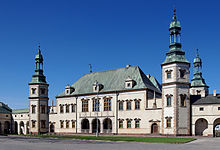






.jpg/166px-Kościół_Najświętszego_Serca_Jezusowego_w_Skarżysku-Kamiennej_-_fotopolska.eu_(562302).jpg)







_z_lotu_ptaka.jpg/350px-Ozarow_(Swietokrzyski)_z_lotu_ptaka.jpg)







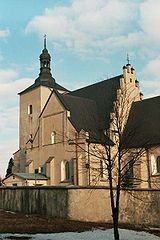

1.jpg/350px-Szydlow(js)1.jpg)







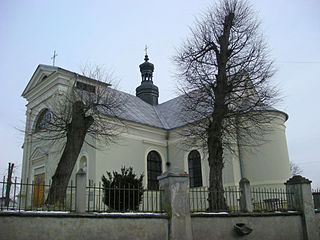






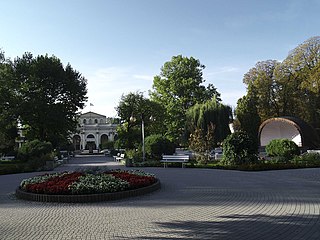


.jpg/350px-Bazylika_kolegiacka_Narodzenia_NMP_oraz_Muzeum_Regionalne_w_Wiślicy_(8642909276).jpg)

.JPG/320px-Opatowiec_-_after_Dominican_church_of_St._James_(1).JPG)





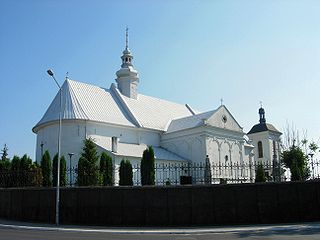
_ID_643994.jpg/350px-SM_Włoszczowa_Kościół_Wniebowzięcia_NMP_(1)_ID_643994.jpg)











.jpg/320px-John_Paul_II_Airport_in_Balice-Kraków_night_november_2017(3).jpg)




